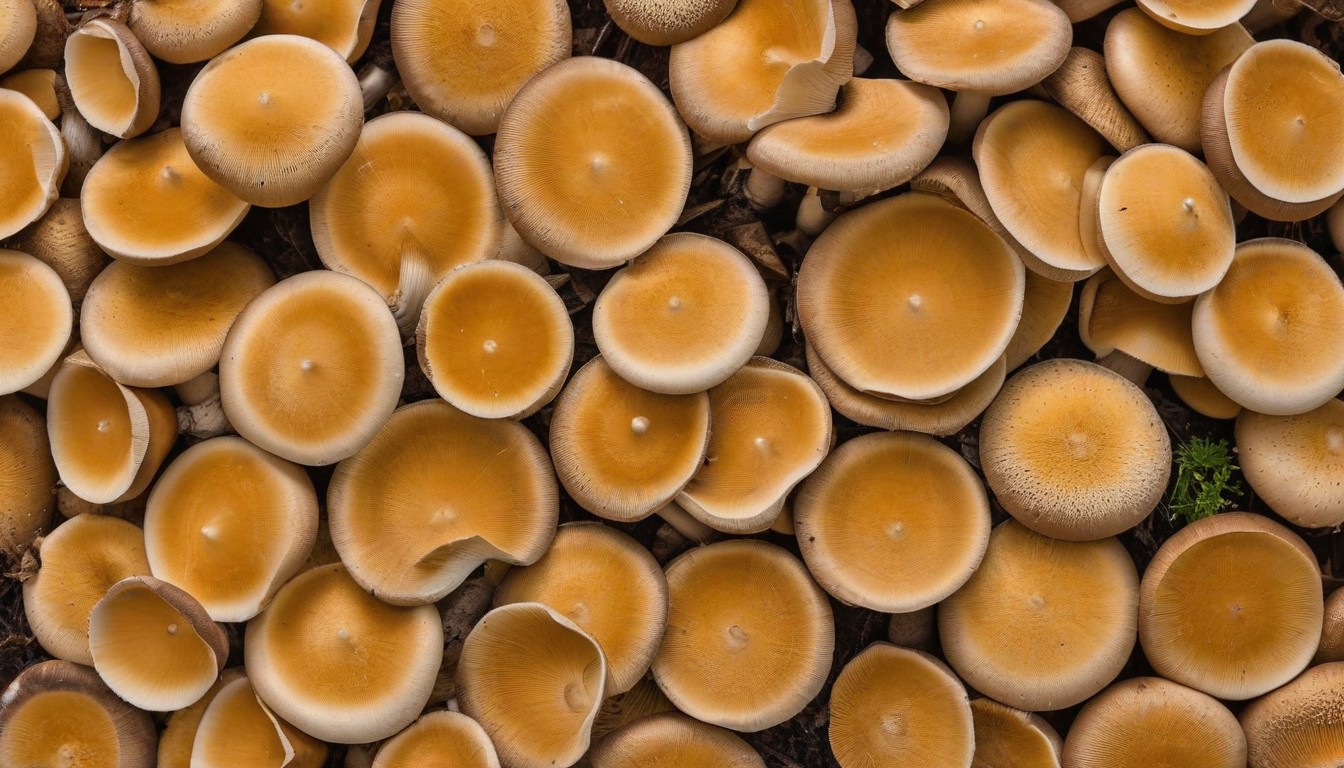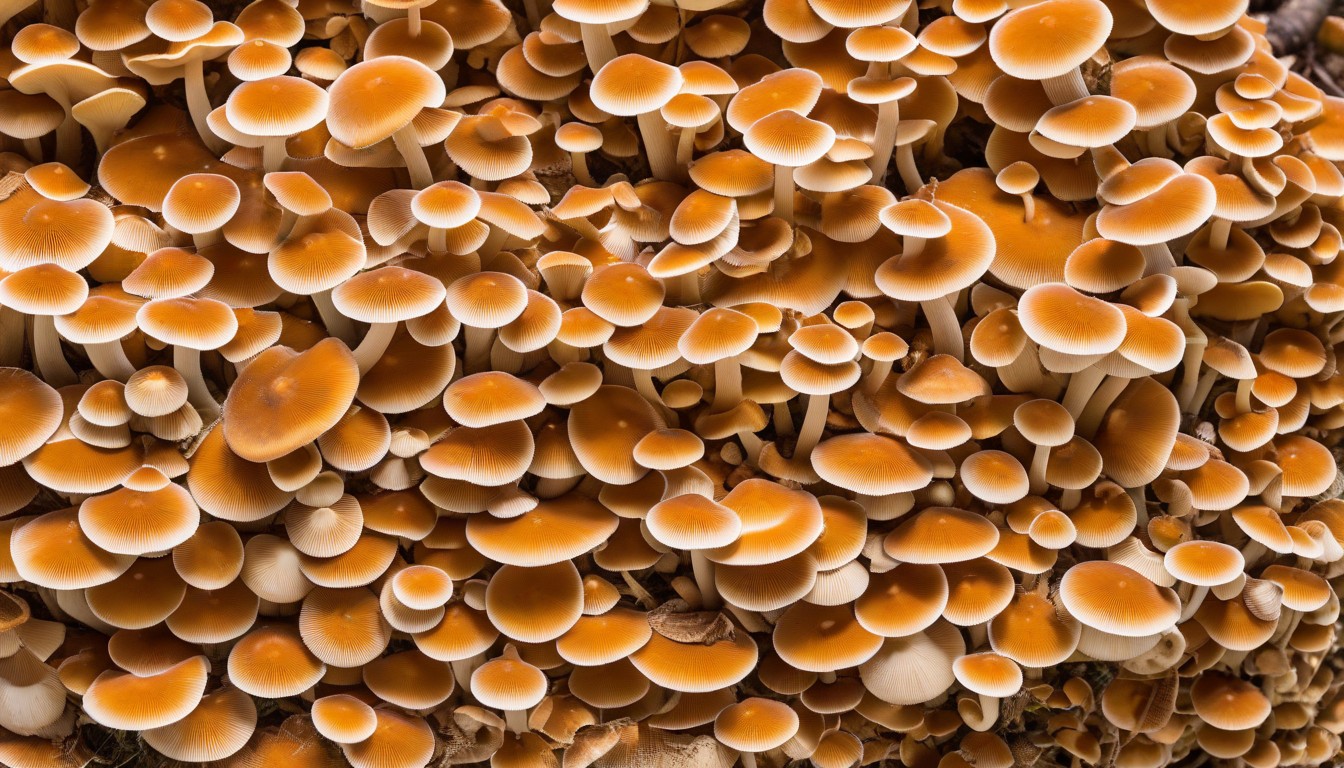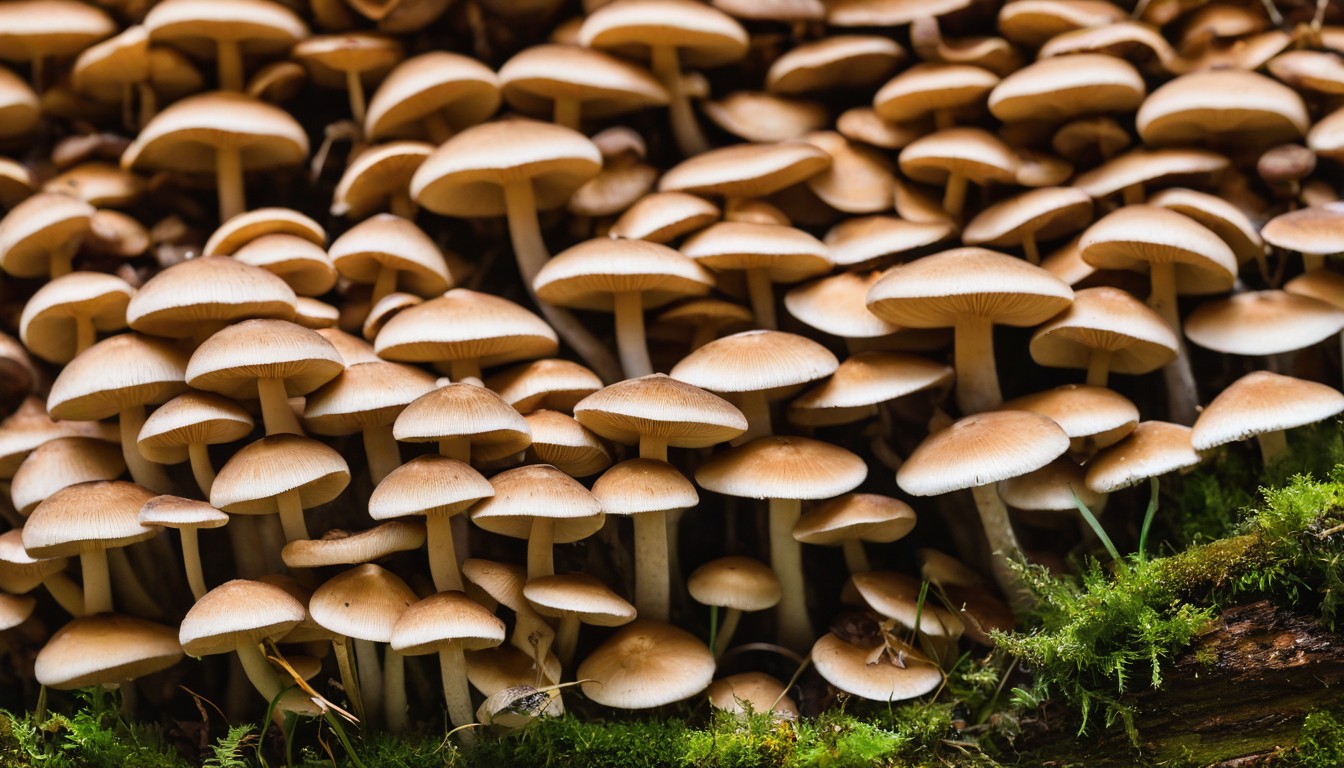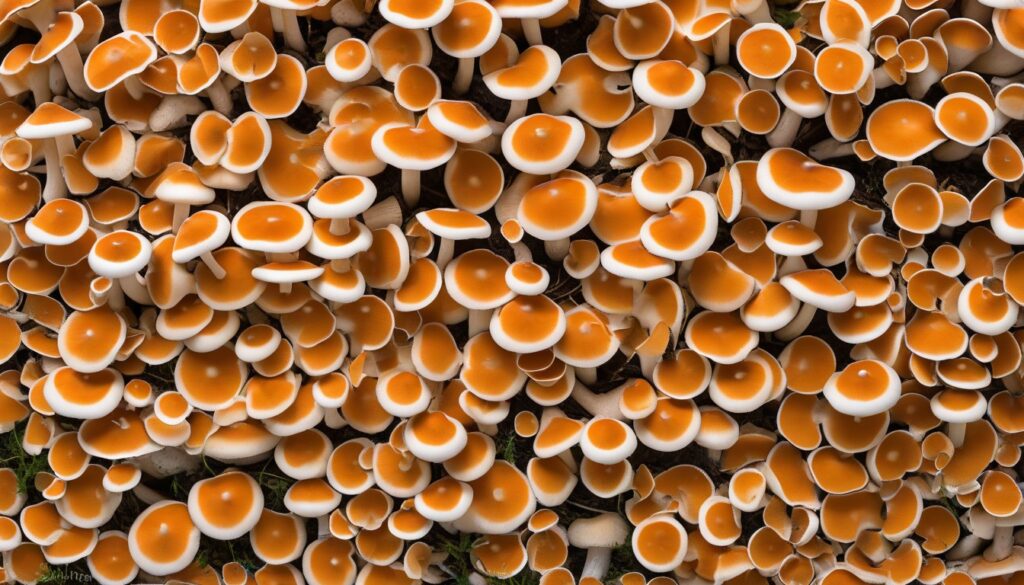If you’re looking to cultivate bountiful casing layer mushrooms, you’ve come to the right place. In this article, we’ll reveal expert tips and secrets on how to create the perfect growth environment for your mushrooms.
Key Takeaways
- Learn what a casing layer is and its role in mushroom cultivation.
- Understand the importance of choosing the right casing ingredients for optimal growth.
- Discover proper preparation and sterilization techniques for the casing layer.
- Explore different application techniques to maximize mushroom production.
- Learn how to maintain the ideal temperature and humidity conditions for your mushrooms to thrive.
What is a Casing Layer in Mushroom Cultivation?
In mushroom cultivation, a casing layer refers to a substrate layer applied on top of the mushroom spawn and substrate.
The casing layer serves as the growth medium for the fruiting body of the mushroom and provides additional nutrients that help promote optimal growth and development.
The casing layer also helps to increase the water retention of the substrate, allowing for a more humid environment, which is beneficial for mushroom production.
There are various types of materials used for casing layers, including peat moss, vermiculite, and coir, and they can be mixed in different ratios to achieve the desired mushroom growth properties.
“The primary role of the casing layer is to provide the necessary humidity for pinhead initiation and a receptive microenvironment for fruit body development,”
|
Benefits of Using a Casing Layer: |
|---|
|
• Provides essential nutrients for optimal mushroom growth |
|
• Increases water retention of the substrate |
|
• Fosters a more humid growing environment |
|
• Encourages pinhead initiation |
|
• Enhances fruit body development |
In the next section, we will take a closer look at how to select the right casing layer ingredients for optimal mushroom growth.
Choosing the Right Casing Ingredients
Choosing the correct casing mix is essential for achieving optimal mushroom growth. There are several types of casing ingredients available, including:
|
Type |
Properties |
|---|---|
|
Peat Moss |
Retains moisture and provides nutrients for mushrooms to grow. |
|
Vermiculite |
Offers efficient water retention and good aeration to support mushroom development. |
|
Coir |
Provides a perfect growing medium and nutrient-rich environment for mushrooms. |
Depending on the mushroom species and growing conditions, different combinations of these ingredients should be used to achieve the ideal mix with the right pH and nutrient content. To make sure you are choosing the right components for your casing layer, conduct a pH test before mixing and sterilizing the ingredients. Furthermore, make sure the ingredients are organic and free from contaminants.
Remember, each mushroom variety has different nutritional and pH requirements, so it’s important to tailor your casing layer mix to your specific mushroom type for optimal results.
Preparing and Sterilizing the Casing Layer

When it comes to growing healthy casing layer mushrooms, proper preparation and sterilization of the casing layer is key. This ensures a healthy growing environment, free from bacteria and other harmful pathogens.
The first step in preparing the casing layer is to mix the ingredients thoroughly. Use a large sterilized container to mix the casing layer materials, which typically consist of peat moss, vermiculite, and limestone. Add water gradually while stirring until you achieve the desired moisture content. Be careful not to add too much water, as this can lead to poor growth and contamination.
Once the casing layer mix is well blended, it’s time to sterilize it. Sterilization involves killing off all the bacteria and fungi present in the casing layer to ensure that only the mushroom mycelium can grow. This is done using a pressure cooker or autoclave, which is heated to high temperatures for several hours. Ensure that the container is sealed tightly during this process to prevent contamination.
After sterilizing the casing layer, allow it to cool before applying it to your mushroom substrate. This will prevent the mycelium from being damaged by the high temperatures.
Expert Tip: Consider adding supplements to your casing layer mix to enhance its nutrient content. Calcium carbonate and gypsum are often used to provide a source of calcium for the mushroom mycelium, while coffee grounds and cocoa shells can add extra nutrients.
Application Techniques for Casing Layer
Now that you have prepared the casing layer for your mushrooms, it’s time to apply it properly. The right application techniques can create even coverage of your casing layer and optimize mushroom production. Here are some tips to ensure that your application techniques are on point:
- Apply uniformly: Ensure that the casing layer is applied evenly throughout the growing container to avoid areas that can dry out or become saturated.
- Avoid physical compaction: Gently apply the casing layer without packing or pressing it down. Compaction can cause the casing layer to lose its structure and lead to poor mushroom growth.
- Use a sterilized spoon: Use a clean spoon or trowel to apply the casing layer. Ensure that your spoon is sterilized, sanitized, and free of contaminants that can impact mushroom growth.
Keep in mind that the casing layer needs to be moist when it is applied. If it has dried out, it can lead to patchy or non-existent mycelium growth. Proper application of the casing layer is just one of the steps in the optimal growth process for casing layer mushrooms.
Take a look at the table below for an overview of the different application techniques for casing layer mushrooms:
|
Application Techniques |
Description |
|---|---|
|
Top Dressing Method |
This method involves spreading a thin layer of casing mixture over the top of the substrate to enhance mycelium growth. |
|
Patching Method |
This method is used to fill in any gaps or bare spots on your casing layer. It involves using a sterilized spoon or trowel to patch up the gaps. |
|
Filling Container Method |
This method involves filling the growing container with substrate and then adding the casing layer mixture on top to promote even coverage. |
Using the right application technique can make a significant difference in the growth and productivity of your casing layer mushrooms. Experiment with these techniques and find the right one that works best for you.
Maintaining the Ideal Temperature and Humidity

Proper temperature and humidity levels are essential for the growth of healthy casing layers and a bountiful harvest. Keep the following tips in mind to maintain the optimal conditions:
- Temperature: The ideal temperature for casing layer mushrooms is between 18-23°C (64-73°F). Monitor the temperature with a thermometer and make sure it does not fall below or exceed the recommended range.
- Humidity: The casing layer requires a humid environment to thrive. Maintain the humidity level between 85-95% by misting the growing area regularly or using a humidifier. Be careful not to over-mist or create standing water, as this can promote the growth of harmful microorganisms.
- Ventilation: Adequate air circulation is necessary to prevent the growth of harmful pathogens and ensure a healthy growing environment. Provide ventilation by opening windows or using fans, but be careful not to create drafts that can disturb the mushrooms or dry out the casing layer.
Remember to regularly monitor the temperature and humidity levels, and make adjustments as necessary to maintain the ideal environment for your casing layer mushrooms. With proper maintenance, you can expect a successful harvest of healthy and flavorful mushrooms.
Watering and Fruiting the Casing Layer
Proper watering and fruiting techniques are essential to ensure optimal growth and development of your casing layer mushrooms. The amount and frequency of watering will depend on the humidity level and temperature of your cultivation environment. Overwatering can lead to waterlogged substrate, which can cause contamination, while under-watering can cause dehydration and stunted growth.
Once the mycelium has colonized the casing layer, fruiting can begin. It’s essential to maintain high humidity levels to promote healthy fruiting. Ensure adequate ventilation to prevent excessive humidity, which can lead to bacterial and mold growth. Use a fine mist spray bottle to mist the casing layer surface and maintain the desired humidity levels.
|
Watering and Fruiting Tips |
|---|
|
Water the casing layer when the surface begins to dry out, but before it becomes visibly parched. |
|
Use distilled or sterile water to prevent contamination. |
|
Aim to keep the relative humidity between 85% and 95% for optimal fruiting. |
|
Place a humidifier in your cultivation space to maintain consistent humidity levels. |
|
Fan the fruiting chamber several times a day to provide air exchange and help prevent bacterial and fungal growth. |
Remember to monitor your mushrooms for signs of dehydration or excess moisture. Adjust your watering and fruiting techniques accordingly to maintain optimum conditions for healthy fruiting.
Common Pests and Diseases to Watch Out For

As with any type of crop, casing layer mushrooms are susceptible to pests and diseases that can harm or destroy your yield. Some of the most common pests to watch out for include:
- Spider mites – These tiny pests can cause damage to the leaves and stems of your mushrooms. Look for fine webbing on your crops.
- Thrips – Another common pest that can damage leaves and stunts the growth of your mushrooms. Look for black or brown streaks on the leaves.
- Aphids – These insects feed on the sap of your mushrooms and can cause wilting and stunting. Look for clusters of aphids on your crops.
There are also several diseases that can affect your casing layer mushrooms:
- Mushroom virus X (MVX) – This virus causes distorted growth and discolored mushrooms. It can also reduce your yield.
- Wet bubble disease – This fungus causes soft, watery brown spots on the cap of the mushroom. It can spread quickly and ruin your entire crop.
- Dry bubble disease – This fungus causes small, dry spots on the cap of the mushroom. While it doesn’t spread as quickly as wet bubble disease, it can still ruin your yield.
To prevent pests and diseases from affecting your crops, practice good sanitation by keeping your growing area clean and sterilized. If you do notice signs of pest or disease infestations, act quickly to prevent their spread. There are many organic treatments available, such as insecticidal soap and neem oil, that can help combat these problems.
Harvesting and Storing Casing Layer Mushrooms
Harvesting casing layer mushrooms is a delicate process that requires careful attention to ensure that the mushrooms are not damaged. Ideally, the harvest should begin when the mushrooms are small and firm, but before the veil under the cap breaks. By harvesting early, you can encourage the growth of additional mushrooms, leading to a higher yield overall.
When harvesting, gently twist and pull the mushrooms from the casing layer, being careful not to damage the neighboring mushrooms or the casing layer itself. After harvesting, the mushrooms should be cleaned and sorted, discarding any that are damaged or have begun to rot.
Once sorted, the mushrooms should be stored in a refrigerated space with a temperature between 34 and 38°F and a humidity between 85-90%. Mushrooms are sensitive to moisture, so be careful not to store them in a location where the humidity is too high or they may become mushy and unappetizing.
For best results, store the mushrooms in a perforated plastic bag to allow for proper air circulation. Avoid storing the mushrooms for too long, as they will continue to respire, leading to a loss of quality and freshness over time.
Troubleshooting Common Issues in Casing Layer Mushroom Cultivation
Despite our best efforts, problems may arise during the manufacturing process of casing layer mushrooms. Understanding and identifying these common issues is essential to ensure optimal yield and avoid losses. Here are some of the most typical problems and solutions:
Problem: Lack of growth or slow growth
Possible Reasons:
- Poor quality substrate
- Insufficient moisture
- Low temperatures
Solution: Adjust the substrate formula (pH level, nutrient composition), increase moisture and temperature levels, and ensure proper pasteurization or sterilization.
Problem: Mold or bacterial contamination
Possible Reasons:
- Low sterilization temperature
- Contaminated substrate or casing ingredients
- Unsanitary environment
Solution: Discard contaminated material, sanitize equipment and work area regularly, use higher sterilization temperatures, and ensure proper air exchange and ventilation.
Problem: Uneven or sparse pinning
Possible Reasons:
- Non-uniform application of casing layer
- Insufficient or excessive humidity
- Low light or inadequate CO2 levels
Solution: Apply casing layer evenly, adjust humidity levels to optimal levels, ensure adequate lighting and CO2 concentration, and ensure proper ventilation.
Expert Tip: “Regularly monitoring the temperature, humidity, and appearance of your casing layer mushrooms can help you detect and solve problems before they escalate.”
Problem: Poor fruiting or small mushroom size
Possible Reasons:
- Insufficient aeration
- Inappropriate harvesting techniques
- Inadequate spacing between mushrooms
Solution: Provide proper aeration, space mushrooms at appropriate distances, avoid injuring other mushrooms when harvesting, and use proper harvesting and storage techniques.
By addressing these common issues and applying appropriate solutions, you can avoid setbacks and achieve optimal yields in your casing layer mushroom cultivation.
Advanced Techniques for Enhanced Casing Layer Mushroom Growth

Looking to take your casing layer mushroom cultivation to the next level? Consider these advanced techniques to enhance growth and productivity.
1. Coir Supplementation
Coir is a natural, environmentally friendly substrate that can help to boost mushroom growth. Consider supplementing your casing layer mixture with coir for enhanced yields.
2. Cold Shocking
Cold shocking involves exposing your mushroom mycelium to a brief period of cool temperatures, which can stimulate fruiting and increase yields. Experiment with cold shocking techniques to see if it works for your cultivation method.
3. Gypsum Application
Gypsum is a natural mineral that can help to improve the structure and water-holding capacity of your casing layer mixture. Try adding gypsum to your casing layer to promote healthy mycelium growth and fruiting.
4. Light Exposure
Exposing your mushrooms to light during the fruiting stage can promote larger, healthier caps and overall growth. Consider using LED lights or natural sunlight to provide your mushrooms with the ideal amount of light exposure.
5. Spawn Run Extension
Extending the spawn run period can allow your mycelium to colonize the casing layer more thoroughly, leading to more bountiful and even mushroom growth. Experiment with extending your spawn run to see if it increases your yields.
|
Technique |
Potential Benefits |
|---|---|
|
Coir Supplementation |
Enhanced yields |
|
Cold Shocking |
Stimulated fruiting, increased yields |
|
Gypsum Application |
Improved soil structure, healthy mycelium growth |
|
Light Exposure |
Larger, healthier caps, improved overall growth |
|
Spawn Run Extension |
Bountiful, even mushroom growth |
When it comes to casing layer mushroom cultivation, there are always new techniques and innovations to explore. Try integrating these advanced techniques into your cultivation methods to see if they improve your yields and enhance your mushroom growing experience.
Conclusion
By following the optimal growth secrets for cultivating casing layer mushrooms, you can achieve bountiful yields with high quality and a longer shelf life. Remember to choose the right casing ingredients, prepare and sterilize the casing layer properly, apply it evenly, maintain the ideal temperature and humidity, and water and fruit your mushrooms effectively.
Be sure to watch out for common pests and diseases and troubleshoot any issues that may arise during the cultivation process. And for those looking to take their growing game to the next level, explore advanced techniques that can enhance the growth and productivity of your casing layer mushrooms even further.
With these tips and techniques, you can become a master mushroom cultivator and enjoy the delicious and nutritious fruits of your labor. Happy growing!
FAQ
What is a casing layer and why is it important in mushroom cultivation?
A casing layer is a protective layer of substrate that is applied to the mycelium-covered substrate base in mushroom cultivation. It provides a moist and protective environment for the mushrooms to grow, helps regulate humidity, and improves yield and fruiting.
How do I choose the right ingredients for my casing layer?
When choosing casing ingredients, it’s important to consider the water-holding capacity, pH balance, and nutrient content. Popular ingredients include peat moss, vermiculite, and limestone. The ratio and composition can vary depending on the mushroom species and desired results.
How do I prepare and sterilize the casing layer?
To prepare the casing layer, mix the chosen ingredients thoroughly and moisten it to the optimal hydration level. Sterilization can be achieved by steaming or baking the casing mixture in a sterile container. This helps eliminate potential contaminants and creates a favorable environment for mushroom growth.
What are the different application techniques for the casing layer?
Common application techniques include top dressing, raking, and spraying. Top dressing involves evenly spreading the casing layer over the substrate, while raking helps achieve a more uniform distribution. Spraying the casing layer with water can aid in moisture retention and promote mycelium colonization.
How do I maintain the ideal temperature and humidity for casing layer mushrooms?
The ideal temperature varies depending on the mushroom species, but generally falls between 60-75°F (15-24°C). Maintaining humidity levels of around 90% is vital for proper casing layer development and mushroom growth. Using a humidifier, misting the environment, and monitoring with a hygrometer can help control these factors.
Why is proper watering and fruiting important for the casing layer?
Watering the casing layer ensures proper moisture content, which supports mycelium growth and allows for the formation of fruiting bodies. Fruiting, or the initiation of mushroom growth, requires specific temperature, humidity, and air exchange conditions to trigger the reproductive stage.
What are some common pests and diseases that can affect casing layer mushrooms?
Common pests include fungus gnats, mites, and molds, while diseases such as bacterial blotch and green mold can also pose problems. Maintaining cleanliness, proper ventilation, and using preventive measures like biological controls and proper sterilization can help prevent and manage these issues.
How do I harvest and store casing layer mushrooms?
Harvesting should be done when the mushrooms have reached their desired size and just before the veil breaks. Gently twist or cut the mushrooms at the base to avoid damaging the mycelium. Store the harvested mushrooms in a cool, humid environment to maintain freshness and extend shelf life.
What are some common issues that may occur during casing layer mushroom cultivation?
Common issues include slow mycelium colonization, insufficient pinning, and yield fluctuations. These can be caused by improper environmental conditions, contamination, or substrate imbalance. Adjusting temperature, humidity, and substrate composition, as well as practicing good hygiene and sterile techniques, can help troubleshoot these issues.
Are there advanced techniques to enhance casing layer mushroom growth?
Advanced techniques include adjusting CO2 levels, implementing light cycles, and using specialized supplements to promote robust growth. These techniques require a deeper understanding of the specific mushroom species and experimentation to optimize results.

